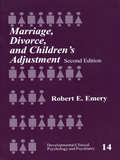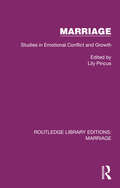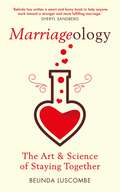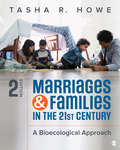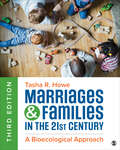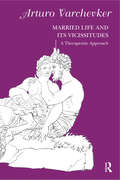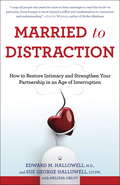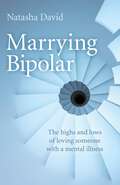- Table View
- List View
Marriage and Relationship Education
by W. Kim Halford Jeffry LarsonGrounded in extensive research and clinical experience, this indispensable book addresses the "whats," "whys," and "how-tos" of conducting effective marriage and relationship education. Leading authority W. Kim Halford reviews a range of contemporary models and provides an in-depth description of his own approach, Couple CARE. Session-by-session guidelines for therapists show how to help groups or individual couples including those facing major life changes or stressors foster closeness and communication, manage conflicts, and prevent common relationship problems. The book also explains how to use commercially available online assessment tools to help each couple develop their own relationship goals. It includes 35 reproducible handouts and forms.
Marriage and the Culture of Peace: Communication Skills for Families, Therapists, and Society
by Cecilia Sarahi de la Rosa Vazquez Paris A. Cabello-TijerinaThis book provides skills for therapists and families to help improve interpersonal communication, promoting a new system of family coexistence and a refreshed concept of the modern marriage in society. Written from a constructivist peace perspective, the book’s aim is to reduce the high statistics of intimate partner violence that occurs in Mexico, arguing that the culture of peace and how it is born in the family in turn affects society for better or for worse. Based upon interviews from 150 long-term married couples, the chapters address the components that promote peaceful dialogue in marriages, such as assertive language, active listening, tolerance to frustration, and gender perspectives. Including accessible language and several models of peace, the book uniquely examines same-sex marriages, the role of children in marriage conflicts, and prescribed gender assumptions and roles in relationships. It aims to empower family members to move away from old habits and seek a more equitable existence in marriages and society at large. This interdisciplinary text will be of great interest to family therapists and clinical social workers, as well as to students and researchers in communication and peace studies.
Marriage, Divorce, and Children's Adjustment
by Dr Robert E. EmeryThis completely updated second edition presents an integrated, multidisciplinary account of children's experiences of divorce from historical, cultural and demographic perspectives. The author highlights children's resilience, but is sensitive to children's pain throughout the divorce process and afterwards. In addition he reviews the psychological, social, economic and legal consequences of divorce, and examines how children's risk is predicted by parental conflict, relationships with both parents, financial strain, custody disputes, and other factors. The author uses his family systems model to integrate research findings into a theoretical whole and to evaluate psychological interventions with divorcing and divorced families.
Marriage, Past and Present: A Debate between Robert Briffault and Bronislaw Malinowski
by Bronislaw Malinowski Robert BriffaultDelve into the fascinating and thought-provoking world of anthropological and sociological discourse with Marriage, Past and Present: A Debate between Robert Briffault and Bronislaw Malinowski. This compelling work captures the intellectual clash between two of the early 20th century's most prominent scholars as they explore the evolution and significance of marriage in human societies.Robert Briffault, a noted anthropologist and sociologist, and Bronislaw Malinowski, a pioneering figure in social anthropology, bring their distinctive perspectives and expertise to this vigorous debate. Through a series of essays and counterarguments, they examine the historical development of marriage, its cultural variations, and its role in contemporary society.Briffault, known for his critical views on the institution of marriage, argues that marriage has evolved primarily as a social contract influenced by economic and political factors. He challenges traditional notions of marriage as a natural and universal institution, proposing instead that it is a construct shaped by specific historical and cultural contexts.In contrast, Malinowski, celebrated for his fieldwork and functionalist approach, defends the idea of marriage as a fundamental and universal aspect of human societies. He emphasizes the biological and social functions of marriage, including the regulation of sexual relations, the rearing of children, and the establishment of kinship networks.Join Robert Briffault and Bronislaw Malinowski in this enlightening and engaging exploration of marriage, and discover the varied interpretations and meanings of this enduring social institution. Marriage, Past and Present is a timeless contribution to the study of human relationships and cultural evolution.
Marriage: Studies in Emotional Conflict and Growth (Routledge Library Editions: Marriage)
by Lily Pincus‘What are marriage difficulties really all about?’ This fundamental question, and the allied one of how help can be given to those in trouble in their marriages, constitute the theme of this book. Originally published in 1960, the authors were a group of caseworkers who over the previous ten years had treated and studied the problems of about 2,000 married couples. They worked as a closely-knit specialist unit in co-operation with psychiatric consultants from the Tavistock Clinic. The work is based on the psycho-analytic theory of personality development and human relationships. This theory is supported by five detailed case-studies which form the central part of the book. The main purpose is to demonstrate the particular therapeutic technique which has been evolved. The book would have been of interest to social workers, doctors and all who were concerned to make marriages as rich a source of happiness as possible at the time. Today it can be read and enjoyed in its historical context.
Marriageology: The Art and Science of Staying Together
by Belinda LuscombeThe fault lines that can fracture a marriage are all contained in these six words: FAMILIARITY, FIGHTING, FAMILY, FINANCES, FOOLING AROUND AND FINDING HELP. It&’s time to get to know your F words. Using the latest scientific research, personal anecdotes and expert advice, award-winning journalist Belinda Luscombe argues that marriage is good for your health, your finances and your happiness. But it isn&’t always easy! Focusing on what Belinda describes as her F words, she presents facts, debunks myths, and provides an entertaining mix of data, anecdotes and wisdom from a wide range of approaches to married life, drawing on the work of experts from within the marriage and divorce industries. A brilliant guide to staying together, Marriageology offers helpful advice and gives readers something to think about whether your marriage is on the brink of collapse or just needs a bit of maintenance.
Marriages and Families in the 21st Century: A Bioecological Approach
by Dr Tasha R. HoweMarriages and Families in the 21st Century puts contemporary relationships and family structures in context for today’s students. Using a bioecological framework, the book reveals how families are shaped by multiple influences, from biological to cultural, that interact with one another. Chapters cover topics from parenting to gender issues within an interdisciplinary context, weaving in stories, visuals, and examples of diverse families to dispel longstanding myths. The book creates a personalized learning experience with frequent self-assessments and strengths exercises, while ensuring that students come to understand the research and build scientific analysis and critical thinking skills along the way. Robust digital tools and resources including SAGE edge and an interactive eBook with SAGE Premium Video help readers develop a multi-layered understanding of "what makes families tick" while challenging them to re-evaluate their own assumptions and experiences.
Marriages and Families in the 21st Century: A Bioecological Approach
by Dr Tasha R. HoweMarriages and Families in the 21st Century puts contemporary relationships and family structures in context for today’s students. Using a bioecological framework, the book reveals how families are shaped by multiple influences, from biological to cultural, that interact with one another. Chapters cover topics from parenting to gender issues within an interdisciplinary context, weaving in stories, visuals, and examples of diverse families to dispel longstanding myths. The book creates a personalized learning experience with frequent self-assessments and strengths exercises, while ensuring that students come to understand the research and build scientific analysis and critical thinking skills along the way. Robust digital tools and resources including SAGE edge and an interactive eBook with SAGE Premium Video help readers develop a multi-layered understanding of "what makes families tick" while challenging them to re-evaluate their own assumptions and experiences.
Marriages and Families in the 21st Century: A Bioecological Approach
by Tasha R. HoweIn Marriages and Families in the Twenty-First Century: A Bioecological Approach, Tasha R. Howe′s unique micro-to-macro perspective invites all readers to explore the full complexity of contemporary relationships and family structures within their ever-changing social, cultural, psychological, and biological frameworks. The illuminating narrative leads students into the future of the field by uniting the latest developmental science with everyday examples that place the individual within the context of family, peers, neighbors, teachers, schools, media, religious institutions, and culture. The Third Edition encourages students to analyze and apply the material with abundant self-reflection exercises, self-assessments, case studies, and critical-thinking questions, providing them with a firm grasp of the research as well as concrete tools to use in their own lives, relationships, and careers. This title is accompanied by a complete teaching and learning package. Contact your SAGE representative to request a demo. Learning Platform / Courseware SAGE Vantage is an intuitive learning platform that integrates quality SAGE textbook content with assignable multimedia activities and auto-graded assessments to drive student engagement and ensure accountability. Unparalleled in its ease of use and built for dynamic teaching and learning, Vantage offers customizable LMS integration and best-in-class support. It’s a learning platform you, and your students, will actually love. Learn more. Assignable Video with Assessment Assignable video (available in SAGE Vantage) is tied to learning objectives and curated exclusively for this text to bring concepts to life. Watch a sample video now. LMS Cartridge: Import this title’s instructor resources into your school’s learning management system (LMS) and save time. Don’t use an LMS? You can still access all of the same online resources for this title via the password-protected Instructor Resource Site. Learn more.
Marriages and Families in the 21st Century: A Bioecological Approach
by Tasha R. HoweIn Marriages and Families in the Twenty-First Century: A Bioecological Approach, Tasha R. Howe′s unique micro-to-macro perspective invites all readers to explore the full complexity of contemporary relationships and family structures within their ever-changing social, cultural, psychological, and biological frameworks. The illuminating narrative leads students into the future of the field by uniting the latest developmental science with everyday examples that place the individual within the context of family, peers, neighbors, teachers, schools, media, religious institutions, and culture. The Third Edition encourages students to analyze and apply the material with abundant self-reflection exercises, self-assessments, case studies, and critical-thinking questions, providing them with a firm grasp of the research as well as concrete tools to use in their own lives, relationships, and careers. This title is accompanied by a complete teaching and learning package. Contact your SAGE representative to request a demo. Learning Platform / Courseware SAGE Vantage is an intuitive learning platform that integrates quality SAGE textbook content with assignable multimedia activities and auto-graded assessments to drive student engagement and ensure accountability. Unparalleled in its ease of use and built for dynamic teaching and learning, Vantage offers customizable LMS integration and best-in-class support. It’s a learning platform you, and your students, will actually love. Learn more. Assignable Video with Assessment Assignable video (available in SAGE Vantage) is tied to learning objectives and curated exclusively for this text to bring concepts to life. Watch a sample video now. LMS Cartridge: Import this title’s instructor resources into your school’s learning management system (LMS) and save time. Don’t use an LMS? You can still access all of the same online resources for this title via the password-protected Instructor Resource Site. Learn more.
Marriages and Families: Intimacy, Diversity, and Strengths
by David H. Olson John Defrain Linda SkograndSince the first edition in 1994, Marriages and Families: Intimacy, Diversity, and Strengths has helped thousands of college students learn how to create and maintain enduring intimate relationships. Three distinctive themes of intimacy, marital and family strengths, and diversity are woven throughout the text, with the goal of integrating research, theory, and practical ideas to promote healthy and productive relationships.
Marriages and Families: Intimacy, Diversity, and Strengths
by David H. OlsonMarriages and Familiesprovides students with the information they need to learn how to create and maintain enduring intimate relationships. Three distinctive themes of intimacy, martial and family strengths, and diversity are woven throughout the text, while integrating research, theory, and practical ideas to promote healthy and productive relationships.
Marriages, Families, And Relationships: Making Choices In A Diverse Society
by Mary Ann Lamanna Agnes Riedmann Susan D. StewartLamanna/Riedmann/Stewart's bestselling MARRIAGES, FAMILIES, AND RELATIONSHIPS: MAKING CHOICES IN A DIVERSE SOCIETY, 14th edition, emphasizes a theme that is especially relevant in our modern and global world: making choices in a diverse society. Combining various theoretical perspectives with relevant examples, the text will help you understand how people are influenced by the society around them, how social conditions change in ways that affect family life, the interplay between families and the larger society, and the family-related choices that individuals make throughout adulthood. You'll gain insightful perspectives on different ethnic traditions and family forms. You will also be empowered to question assumptions and reconcile conflicting ideas and values as you make informed choices in your own life. In addition, MindTap digital learning solution helps you learn on your own terms.
Marriages, Families, and Relationships: Making Choices in a Diverse Society
by Mary Ann Lamanna Agnes Riedmann Susan D. StewartThis best-selling text on marriages, families, and relationships combines an authoritative, yet applied approach with a theme that is especially relevant today: making choices in a diverse society. A balance of various theoretical perspectives along with many examples helps readers understand how people are influenced by the society around them, how social conditions change in ways that affect family life, the interplay between families and the larger society, and the family-related choices that individuals make throughout adulthood. Readers gain insightful perspectives on the diversity of our modern society, including different ethnic traditions and family forms, and are encouraged to question assumptions and reconcile conflicting ideas and values as they make informed choices in their own lives.
Married Life and its Vicissitudes: A Therapeutic Approach
by Arturo VarchevkerThis book is about marital relations and its vicissitudes, and the possible way of dealing with them through marital therapy. It reflects the importance of turning marital miscommunications into constructive communications between partners in order to improve their relationship. The psychoanalytic perspective plays a significant role in exploring the marital relationship through the partners' emotional interaction with each other and the effect that their personal emotional development has on their constructive and destructive attitudes. On some occasions, other therapeutic models can be added to reinforce the therapeutic exploration and the possible therapeutic goal. The contributions of Freud and post-Freudians, and later Melanie Klein and her followers, enabled a deeper and wider view to better understand the emotional vicissitudes in marital interaction. A marital relation is an important unit that is placed between the individual and the family and is affected by social and cultural contexts. Beginning a marital relationship implies a significant move or change in the individual's development.
Married Women Who Love Women: And More... (Routledge Mental Health Classic Editions)
by Carren StrockOriginally written in the 1990s, this book remains a key resource for women in heterosexual marriages who discover, or are coming to terms with, their lesbianism or bisexuality. This classic edition includes a new foreword from Ann Northrop—veteran journalist, activist, and co-host of Gay USA—that reflects on the changes in language, intersectionality, and understandings of gender since first publication. Celebrating 25 years since first publication, this book shares the author’s personal story, as well as the descriptive experience of others, to provide validation and empowerment to multitudes of women in their search for their true identities. The author gives women ways in which to structure and restructure their lives and their families after they realize their samegender sexuality. Chapters consider questions such as how women make this discovery, reactions from loved ones, and the outcomes for marriages and families. Updated throughout with contemporary understandings of sexuality and gender, as well as updated language, this book includes a wealth of information, fresh narratives, and stories offering insight into women’s experiences across the country. This is an essential read for women and their partners who are discovering their true identity, as well as therapists, helping professionals, and students of women’s studies, gender studies, sexuality studies, and LGBTQ+ studies programs.
Married Women Who Love Women: And More…
by Carren StrockThis accessible book offers support and advice for women in heterosexual marriages who discover, or are coming to terms with, their lesbianism or bisexuality. It also offers guidance for the single lovers of married women. In sharing the author’s personal story, as well as the descriptive experiences of others, this book provides validation and empowerment to multitudes of women in their search for their true identities. In this third edition of Married Women Who Love Women, the author gives women ways in which to structure and restructure their lives and their families after they realize their same-gender sexuality. Chapters consider questions such as how women make this discovery, reactions from loved ones, and the outcomes for marriages and families. Updated throughout with contemporary understandings of sexuality and gender, this book includes a wealth of information, fresh narratives, and stories offering insight into women’s experiences across the country. This is an essential read for women and their partners who are discovering their true identity, as well as therapists, helping professionals, and students of women’s studies, gender studies, sexuality studies, and LGBTQ studies programs.
Married Women Who Love Women: Second Edition
by Carren StrockThis book is about women in heterosexual marriages who discover or come to terms with their lesbianism or bisexuality. It answers questions such as how women make this discovery, what they do once they realize their same-gender sexuality, how family and friends deal with the situation, and what happens to marriages and families. This second edition contains a new introduction, three new chapters, a glossary of gay-related terms, and a new list of additional reading.
Married to Distraction: Restoring Intimacy and Strengthening Your Marriage in an Age of Interruption
by Edward M. Hallowell Sue George Hallowell Melissa OrlovBestselling author and attention deficit expert, Dr. Hallowell teams up with his couples' therapist wife to explain the subtle yet deadly toll a hectic lifestyle takes on intimate relationships. The author offers strategies for restoring connection and communication.
Married to the Military: A Survival Guide for Military Wives, Girlfriends, and Women in Uniform
by Meredith LeyvaNow revised to reflect the reality of military and economic unrest around the world, Married to the Military remains an invaluable resource for any military spouse or significant other.When you marry a military service member, whether a reservist or active—you may feel as if you&’ve also married the United States military! While there are plenty of orientation books on military training, there is not much information available about handling the personal aspects of military life. Married to the Military demystifies the often confusing military world so you can make the right choices for yourself and your family. Meredith Leyva, an experienced military wife and founder of CinCHouse.com, the Internet&’s largest community for military wives, girlfriends, and women in uniform, offers time-tested advice on everything you need to know—from relocation to deployment, protocol to finances, and career to kids, including: -Keeping your love life together during deployments -Relocating yourself and your family around the world -Maintaining your own career when you're expected to move every three years -Understanding what pay and benefits you're entitled to—and how to maximize them -Dealing with post-traumatic stress disorder (PTSD) and other threats to your partner&’s well-being Whether you&’re figuring out military protocol or trying to understand the medical system, this savvy, friendly yet authoritative guide details just what you need to know to manage day-to-day issues and get on with the adventure of military life.
Marrying Bipolar: The Highs And Lows Of Loving Someone With A Mental Illness
by Natasha DavidOn the last day of winter in 2005, John committed suicide in his car on a lonely side road of the Blue Mountains to the west of Sydney, Australia. He was six months shy of his thirtieth birthday. It was the culmination of nine years of struggle for John and his wife, as he battled undiagnosed mental illness, a gambling addiction, and an earlier suicide attempt. Despite his wife's love and attempts to understand his condition, in the end nothing could save John from his demons. Tragically, John&’s story could be anybody's story. In Australia, around 2,100 people commit suicide every year; up to 12% of people affected by mental illness take their own lives (compared with an average of 1.7% for the whole population), and suicide is the main cause of premature death among people with mental illness. But the effects of suicide are even more far-reaching. Its impact on those left behind is frequently devastating and lifelong. The author knows this first-hand. Marrying Bipolar is the account of a wife&’s struggle to understand the events in her husband&’s life that would eventually lead to their marriage breakdown and his untimely death. Natasha&’s experience watching her husband struggle with the complexity of mental illness, has led her understand the deadly role denial has to play, for both sufferer and partners. In the process, the author addresses her own search of ways to address denial of the darkness that resides in all of us, and the compassion needed to heal and rebuild lives after enduring.
Mars and Venus in Love
by John GrayStraight from the heart -- real-life couples share inspiring, edifying stories of Mars and Venus in love.Millions of readers have learned about relationships from John Gray's previous bestsellers, such as Men Are from Mars, Women Are from Venus, Mars and Venus on a Date; and Mars and Venus in the Bedroom. Inspired by this enthusiasm, Gray asked a number of readers to share their own stories of how they've put his principles to work in their relationships. The result is this amazing collection of first-person accounts-along with Gray's own enlightening commentary-that will have you laughing, crying, and nodding in recognition.Gray's contributors answer such questions as: What problems have you had in your relationship, and how have you overcome them? What special things do you and your partner do for each other? How do you best communicate with each other? How do you practice what you've learned? How does your love feel different now from how it felt before?Their answers illustrate more eloquently than any textbook how to use Gray's advice and counsel to create your own fulfilling, healthy, and loving relationships.
Mars and Venus in Love: Inspiring and Heartfelt Stories of Relationships That Work
by John GrayStraight from the heart -- real-life couples share inspiring, edifying stories of Mars and Venus in love. Millions of readers have learned about relationships from John Gray's previous bestsellers, such as Men Are from Mars, Women Are from Venus, Mars and Venus on a Date; and Mars and Venus in the Bedroom. Inspired by this enthusiasm, Gray asked a number of readers to share their own stories of how they've put his principles to work in their relationships. The result is this amazing collection of first-person accounts-along with Gray's own enlightening commentary-that will have you laughing, crying, and nodding in recognition. Gray's contributors answer such questions as: What problems have you had in your relationship, and how have you overcome them? What special things do you and your partner do for each other? How do you best communicate with each other? How do you practice what you've learned? How does your love feel different now from how it felt before? Their answers illustrate more eloquently than any textbook how to use Gray's advice and counsel to create your own fulfilling, healthy, and loving relationships.
Marte y Venus en el dormitorio: Amor y pasión duraderos en la vida de la pareja (Vintage Espanol Ser.)
by John Gray¿Es la extinción del deseo sexual una ley inexorable de la vida en pareja? Si bien la experiencia de muchos matrimonios parece corroborarlo, no hay nada que lo determine. Partiendo de la idea, universalmente aceptada, de que la pasión sexual es la base de la convivencia en pareja, John Gray identifica uno de sus enemigos más insidiosos: el mutuo desconocimiento de la actitud psicológica e incluso de la reacción fisiológica que tienen hombres y mujeres. Este libro no es una guía sexual convencional, por lo que no se centra en la mecánica del sexo, sino en los principios y métodos para mejorar la comunicación entre los miembros de la pareja, y «mantener viva la magia del enamoramiento».
Marte y Venus salen juntos (Autoayuda Y Superación Ser.)
by John GrayUna lectura indispensable para todos aquellos que tienen una relación y no quieren estropearla, pero también para quienes se sienten atraídos por otra persona y no saben qué pasos dar. Marte y Venus salen juntos es una de las más innovadoras y sugerentes obras en el campo de las relaciones de pareja. Comienza describiendo las cinco fases por las que necesariamente atraviesa toda relación: atracción, incertidumbre, exclusividad, intimidad y compromiso); posteriormente analiza las distintas actitudes ante el proceso y termina con una invitación: la de frecuentar los ciento un lugares donde encontrar el alma gemela.


